Identification and Functional Characterization of an Odorant Receptor Expressed in the Genitalia of Helicoverpa armigera
Abstract
1. Introduction
2. Materials and Methods
2.1. Insect Rearing and Tissue Collection
2.2. Scanning Electron Micrographs (SEMs)
2.3. Total RNA Isolation
2.4. Transcriptome Sequencing and Gene Expression Analysis
2.5. cDNA Synthesis
2.6. Gene Cloning
2.7. Sequence and Phylogenetic Analysis
2.8. Real-Time Quantitative PCR (qPCR)
2.9. Gene Expression in Xenopus Oocytes and Electrophysiological Recordings
3. Results
3.1. The Ultrastructure of External Genitalia of Male and Female Helicoverpa armigera
3.2. Identification of Odorant Receptors in Genitalia in Helicoverpa armigera
3.3. Sequence and Phylogenetic Analysis
3.4. Tissue Expression Pattern of HarmOR68 and HarmOR47
3.5. Functional Analysis of HarmOR68 and HarmOR47
4. Discussion
Author Contributions
Funding
Institutional Review Board Statement
Data Availability Statement
Conflicts of Interest
References
- Bruce, T.J.A.; Wadhams, L.J.; Woodcock, C.M. Insect Host Location: A Volatile Situation. Trends Plant Sci. 2005, 10, 269–274. [Google Scholar] [CrossRef] [PubMed]
- Basu, S.; Clark, R.E.; Fu, Z.; Lee, B.W.; Crowder, D.W. Insect Alarm Pheromones in Response to Predators: Ecological Trade-Offs and Molecular Mechanisms. Insect Biochem. Mol. Biol. 2021, 128, 103514. [Google Scholar] [CrossRef] [PubMed]
- Dweck, H.K.M.; Ebrahim, S.A.M.; Thoma, M.; Mohamed, A.A.M.; Keesey, I.W.; Trona, F.; Lavista-Llanos, S.; Svatoš, A.; Sachse, S.; Knaden, M.; et al. Pheromones Mediating Copulation and Attraction in Drosophila. Proc. Natl. Acad. Sci. USA 2015, 112, E2829–E2835. [Google Scholar] [CrossRef] [PubMed]
- Hansson, B.S.; Stensmyr, M.C. Evolution of Insect Olfaction. Neuron 2011, 72, 698–711. [Google Scholar] [CrossRef] [PubMed]
- Claverie, N.; Steinmann, T.; Bandjee, M.J.; Buvat, P.; Casas, J. Oscillations for Active Sensing in Olfaction: Bioinspiration from Insect Antennal Movements. Bioinspiration Biomim. 2022, 17, 055004. [Google Scholar] [CrossRef] [PubMed]
- Keil, T.A. Fine Structure of a Developing Insect Olfactory Organ: Morphogenesis of the Silkmoth Antenna. Microsc. Res. Tech. 1992, 22, 351–371. [Google Scholar] [CrossRef] [PubMed]
- Callahan, P.S. Insect Antennae with Special Reference to the Mechanism of Scent Detection and the Evolution of the Sensilla. Int. J. Insect Morphol. 1975, 4, 381–430. [Google Scholar] [CrossRef]
- Abalavadi Thammaiah, R.; Pathour, S.; Meshram, N.; Kammar, V.; Majumder, S.; Srivastava, C.; Pandey, K.; Singh, J. Morphological Characterization and Distribution of Antennal Sensilla of Helicoverpa armigera (Hübner) (Lepidoptera: Noctuidae) Using Scanning Electron Microscopy. Microsc. Res. Tech. 2022, 85, 1371–1391. [Google Scholar] [CrossRef] [PubMed]
- Chen, Z.; Liu, F.; Liu, N. Neuronal Responses of Antennal Olfactory Sensilla to Insect Chemical Repellents in the Yellow Fever Mosquito, Aedes aegypti. J. Chem. Ecol. 2018, 44, 1120–1126. [Google Scholar] [CrossRef]
- Wicher, D.; Miazzi, F. Functional Properties of Insect Olfactory Receptors: Ionotropic Receptors and Odorant Receptors. Cell Tissue Res. 2021, 383, 7–19. [Google Scholar] [CrossRef]
- Leal, W.S. Odorant Reception in Insects: Roles of Receptors, Binding Proteins, and Degrading Enzymes. Annu. Rev. Entomol. 2013, 58, 373–391. [Google Scholar] [CrossRef]
- Rützler, M.; Zwiebel, L.J. Molecular Biology of Insect Olfaction: Recent Progress and Conceptual Models. J. Comp. Physiol. A Neuroethol. Sens. Neural Behav. Physiol. 2005, 191, 777–790. [Google Scholar] [CrossRef] [PubMed]
- Sato, K.; Touhara, K. Insect Olfaction: Receptors, Signal Transduction, and Behavior. Results Probl. Cell Differ. 2009, 47, 203–220. [Google Scholar] [CrossRef]
- Lee, S.; Celestino, C.F.; Stagg, J.; Kleineidam, C.; Vickers, N.J. Moth Pheromone-Selective Projection Neurons with Cell Bodies in the Antennal Lobe Lateral Cluster Exhibit Diverse Morphological and Neurophysiological Characteristics. J. Comp. Neurol. 2019, 527, 1443–1460. [Google Scholar] [CrossRef]
- Clyne, P.J.; Warr, C.G.; Freeman, M.R.; Lessing, D.; Kim, J.; Carlson, J.R. A Novel Family of Divergent Seven-Transmembrane Proteins: Candidate Odorant Receptors in Drosophila. Neuron 1999, 22, 327–338. [Google Scholar] [CrossRef] [PubMed]
- Hill, C.A.; Fox, A.N.; Pitts, R.J.; Kent, L.B.; Tan, P.L.; Chrystal, M.A.; Cravchik, A.; Collins, F.H.; Robertson, H.M.; Zwiebel, L.J. G Protein-Coupled Receptors in Anopheles gambiae. Science 2002, 298, 176–178. [Google Scholar] [CrossRef] [PubMed]
- Yan, H.; Jafari, S.; Pask, G.; Zhou, X.; Reinberg, D.; Desplan, C. Evolution, Developmental Expression and Function of Odorant Receptors in Insects. J. Exp. Biol. 2020, 223, jeb208215. [Google Scholar] [CrossRef]
- Du, L.; Zhao, X.; Liang, X.; Gao, X.; Liu, Y.; Wang, G. Identification of Candidate Chemosensory Genes in Mythimna separata by Transcriptomic Analysis. BMC Genom. 2018, 19, 518. [Google Scholar] [CrossRef]
- Yang, S.; Cao, D.; Wang, G.; Liu, Y. Identification of Genes Involved in Chemoreception in Plutella xyllostella by Antennal Transcriptome Analysis. Sci. Rep. 2017, 7, 11941. [Google Scholar] [CrossRef]
- Zhang, L.W.; Kang, K.; Jiang, S.C.; Zhang, Y.N.; Wang, T.T.; Zhang, J.; Sun, L.; Yang, Y.Q.; Huang, C.C.; Jiang, L.Y.; et al. Analysis of the Antennal Transcriptome and Insights into Olfactory Genes in Hyphantria cunea (Drury). PLoS ONE 2016, 11, e0164729. [Google Scholar] [CrossRef]
- Sakurai, T.; Nakagawa, T.; Mitsuno, H.; Mori, H.; Endo, Y.; Tanoue, S.; Yasukochi, Y.; Touhara, K.; Nishioka, T. Identification and Functional Characterization of a Sex Pheromone Receptor in the Silkmoth Bombyx mori. Proc. Natl. Acad. Sci. USA 2004, 101, 16653–16658. [Google Scholar] [CrossRef] [PubMed]
- Nakagawa, T.; Sakurai, T.; Nishioka, T.; Touhara, K. Insect Sex-Pheromone Signals Mediated by Specific Combinations of Olfactory Receptors. Science 2005, 307, 1638–1642. [Google Scholar] [CrossRef] [PubMed]
- Krieger, J.; Grosse-Wilde, E.; Gohl, T.; Dewer, Y.M.E.; Raming, K.; Breer, H. Genes Encoding Candidate Pheromone Receptors in a Moth (Heliothis virescens). Proc. Natl. Acad. Sci. USA 2004, 101, 11845–11850. [Google Scholar] [CrossRef] [PubMed]
- Wang, G.; Vásquez, G.M.; Schal, C.; Zwiebel, L.J.; Gould, F. Functional Characterization of Pheromone Receptors in the Tobacco Budworm Heliothis virescens. Insect Mol. Biol. 2011, 20, 125–133. [Google Scholar] [CrossRef] [PubMed]
- de Fouchier, A.; Walker, W.B.; Montagné, N.; Steiner, C.; Binyameen, M.; Schlyter, F.; Chertemps, T.; Maria, A.; François, M.-C.; Monsempes, C.; et al. Functional Evolution of Lepidoptera Olfactory Receptors Revealed by Deorphanization of a Moth Repertoire. Nat. Commun. 2017, 8, 15709. [Google Scholar] [CrossRef] [PubMed]
- Liu, X.L.; Zhang, J.; Yan, Q.; Miao, C.L.; Han, W.K.; Hou, W.; Yang, K.; Hansson, B.S.; Peng, Y.C.; Guo, J.M.; et al. The Molecular Basis of Host Selection in a Crucifer-Specialized Moth. Curr. Biol. 2020, 30, 4476–4482.e5. [Google Scholar] [CrossRef] [PubMed]
- Martin, F.; Boto, T.; Gomez-Diaz, C.; Alcorta, E. Elements of Olfactory Reception in Adult Drosophila melanogaster. Anat. Rec. 2013, 296, 1477–1488. [Google Scholar] [CrossRef] [PubMed]
- Lemke, R.S.; Pregitzer, P.; Eichhorn, A.S.; Breer, H.; Krieger, J.; Fleischer, J. SNMP1 and Odorant Receptors Are Co-Expressed in Olfactory Neurons of the Labial and Maxillary Palps from the Desert Locust Schistocerca gregaria (Orthoptera: Acrididae). Cell Tissue Res. 2020, 379, 275–289. [Google Scholar] [CrossRef]
- Boronat-Garcia, A.; Iben, J.; Dominguez-Martin, E.; Stopfer, M. Identification and Analysis of Odorant Receptors Ex-pressed in the Two Main Olfactory Organs, Antennae and Palps, of Schistocerca Americana. Sci. Rep. 2022, 12, 22628. [Google Scholar] [CrossRef]
- Chen, R.; Ai, D.; Wang, G.; Wang, B. Comparative Transcriptome Analysis of the Antenna and Proboscis Reveals Feeding State-Dependent Chemosensory Genes in Eupeodes corollae. Open Biol. 2024, 14, 230208. [Google Scholar] [CrossRef]
- Du, Y.; Xu, K.; Ma, W.; Su, W.; Tai, M.; Zhao, H.; Jiang, Y.; Li, X. Contact Chemosensory Genes Identified in Leg Transcriptome of Apis cerana cerana (Hymenoptera: Apidae). J. Econ. Entomol. 2019, 112, 2015–2029. [Google Scholar] [CrossRef] [PubMed]
- Li, Z.; Zhang, Y.; An, X.; Wang, Q.; Khashaveh, A.; Gu, S.; Liu, S.; Zhang, Y. Identification of Leg Chemosensory Genes and Sensilla in the Apolygus lucorum. Front. Physiol. 2020, 11, 276. [Google Scholar] [CrossRef] [PubMed]
- Brennan, P.L.R.; Prum, R.O. Mechanisms and Evidence of Genital Coevolution: The Roles of Natural Selection, Mate Choice, and Sexual Conflict. Cold Spring Harb. Perspect. Biol. 2015, 7, a017749. [Google Scholar] [CrossRef] [PubMed]
- Riolo, P.; Verdolini, E.; Anfora, G.; Minuz, R.L.; Ruschioni, S.; Carlin, S.; Isidoro, N. Perching Mate-Locating Strategy in Paysandisia archon (Lepidoptera: Castniidae): Behavioral and Morpho-Physiological Investigations. J. Econ. Entomol. 2014, 107, 1009–1021. [Google Scholar] [CrossRef] [PubMed]
- Rabieh, M.M.; Esfandiari, M.; Seraj, A.A.; Bonduriansky, R. Genital and Body Allometry in Two Species of Noctuid Moths (Lepidoptera: Noctuidae). Biol. J. Linn. Soc. 2015, 116, 183–196. [Google Scholar] [CrossRef]
- Queiroz-Santos, L.; Casagrande, M.M.; Specht, A. Morphological Characterization of Helicoverpa armigera (Hubner) (Lepidoptera: Noctuidae: Heliothinae). Neotrop. Entomol. 2018, 47, 517–542. [Google Scholar] [CrossRef]
- Liu, Y.; Heath, J.J.; Zhang, S.; van Wijk, M.; Wang, G.; Buellesbach, J.; Wada-Katsumata, A.; Groot, A.T.; Schal, C. A Mosaic of Endogenous and Plant-Derived Courtship Signals in Moths. Curr. Biol. 2023, 33, 3529–3535.e4. [Google Scholar] [CrossRef] [PubMed]
- Cury, K.M.; Prud’homme, B.; Gompel, N. A Short Guide to Insect Oviposition: When, Where and How to Lay an Egg. J. Neurogenet. 2019, 33, 75–89. [Google Scholar] [CrossRef] [PubMed]
- Xu, L.; Jiang, H.-B.; Yu, J.-L.; Lei, Q.; Pan, D.; Chen, Y.; Dong, B.; Liu, Z.; Wang, J.-J. An Odorant Receptor Expressed in Both Antennae and Ovipositors Regulates Benzothiazole-Induced Oviposition Behavior in Bactrocera dorsalis. J. Agric. Food Chem. 2024, 72, 6954–6963. [Google Scholar] [CrossRef]
- Glaser, N.; Gallot, A.; Legeai, F.; Montagne, N.; Poivet, E.; Harry, M.; André Calatayud, P.; Jacquin-Joly, E. Candidate Chemosensory Genes in the Stemborer Sesamia nonagrioides. Int. J. Biol. Sci. 2013, 9, 481–495. [Google Scholar] [CrossRef]
- Xia, Y.-H.; Zhang, Y.-N.; Hou, X.-Q.; Li, F.; Dong, S.-L. Large Number of Putative Chemoreception and Pheromone Biosynthesis Genes Revealed by Analyzing Transcriptome from Ovipositor-Pheromone Glands of Chilo suppressalis. Sci. Rep. 2015, 5, 7888. [Google Scholar] [CrossRef]
- Klinner, C.F.; König, C.; Missbach, C.; Werckenthin, A.; Daly, K.C.; Bisch-Knaden, S.; Stengl, M.; Hansson, B.S.; Große-Wilde, E. Functional Olfactory Sensory Neurons Housed in Olfactory Sensilla on the Ovipositor of the Hawkmoth Manduca sexta. Front. Ecol. Evol. 2016, 4, 130. [Google Scholar] [CrossRef]
- Tom, M.T.; Cortés Llorca, L.; Bucks, S.; Bisch-Knaden, S.; Hansson, B.S. Sex- and Tissue-Specific Expression of Chemosensory Receptor Genes in a Hawkmoth. Front. Ecol. Evol. 2022, 10, 976521. [Google Scholar] [CrossRef]
- Widmayer, P.; Heifetz, Y.; Breer, H. Expression of a Pheromone Receptor in Ovipositor Sensilla of the Female Moth (Heliothis virescens). Insect Mol. Biol. 2009, 18, 541–547. [Google Scholar] [CrossRef] [PubMed]
- Sun, Y.L.; Dong, J.F.; Yang, H.B.; Li, D.X.; Tian, C.H. Identification and Characterization of Chemosensory Receptors in the Pheromone Gland-Ovipositor of Spodoptera frugiperda (J. E. Smith). Insects 2022, 13, 481. [Google Scholar] [CrossRef]
- Li, R.T.; Huang, L.Q.; Dong, J.F.; Wang, C.Z. A Moth Odorant Receptor Highly Expressed in the Ovipositor Is Involved in Detecting Host-Plant Volatiles. eLife 2020, 9, e53706. [Google Scholar] [CrossRef]
- Firempong, S.; Zalucki, M. Host Plant Preferences of Populations of Helicoverpa armigera (Hubner) (Lepidoptera, Noctuidae) From Different Geographic Locations. Aust. J. Zool. 1990, 37, 665–673. [Google Scholar] [CrossRef]
- Liu, Y.; Gu, S.; Zhang, Y.; Guo, Y.; Wang, G. Candidate Olfaction Genes Identified within the Helicoverpa armigera Antennal Transcriptome. PLoS ONE 2012, 7, e48260. [Google Scholar] [CrossRef]
- Zhang, J.; Wang, B.; Dong, S.; Cao, D.; Dong, J.; Walker, W.B.; Liu, Y.; Wang, G. Antennal Transcriptome Analysis and Comparison of Chemosensory Gene Families in Two Closely Related Noctuidae Moths, Helicoverpa armigera and H. assulta. PLoS ONE 2015, 10, e0117054. [Google Scholar] [CrossRef]
- Guo, M.; Chen, Q.; Liu, Y.; Wang, G.; Han, Z. Chemoreception of Mouthparts: Sensilla Morphology and Discovery of Chemosensory Genes in Proboscis and Labial Palps of Adult Helicoverpa armigera (Lepidoptera: Noctuidae). Front. Physiol. 2018, 9, 970. [Google Scholar] [CrossRef]
- Chang, H.; Guo, M.; Wang, B.; Liu, Y.; Dong, S.; Wang, G. Sensillar Expression and Responses of Olfactory Receptors Reveal Different Peripheral Coding in Two Helicoverpa Species Using the Same Pheromone Components. Sci. Rep. 2016, 6, 18742. [Google Scholar] [CrossRef] [PubMed]
- Guo, M.; Du, L.; Chen, Q.; Feng, Y.; Zhang, J.; Zhang, X.; Tian, K.; Cao, S.; Huang, T.; Jacquin-Joly, E.; et al. Odorant Receptors for Detecting Flowering Plant Cues Are Functionally Conserved across Moths and Butterflies. Mol. Biol. Evol. 2021, 38, 1413–1427. [Google Scholar] [CrossRef] [PubMed]
- Zhang, X.; Liu, Y.; Guo, M.; Sun, D.; Zhang, M.; Chu, X.; Berg, B.G.; Wang, G. A Female-Specific Odorant Receptor Mediates Oviposition Deterrence in the Moth Helicoverpa armigera. Curr. Biol. 2024, 34, 1–11.e4. [Google Scholar] [CrossRef] [PubMed]
- Wu, K.; Gong, P. A new practical artificial feed for Helicoverpa Armigera. Entomol. Sin. 1997, 4, 277–282. [Google Scholar]
- Pertea, M.; Pertea, G.M.; Antonescu, C.M.; Chang, T.C.; Mendell, J.T.; Salzberg, S.L. StringTie Enables Improved Reconstruction of a Transcriptome from RNA-Seq Reads. Nat. Biotechnol. 2015, 33, 290–295. [Google Scholar] [CrossRef] [PubMed]
- Zhang, L.; Liu, B.; Zheng, W.; Liu, C.; Zhang, D.; Zhao, S.; Li, Z.; Xu, P.; Wilson, K.; Withers, A.; et al. Genetic Structure and Insecticide Resistance Characteristics of Fall Armyworm Populations Invading China. Mol. Ecol. Resour. 2020, 20, 1682–1696. [Google Scholar] [CrossRef]
- Gouin, A.; Bretaudeau, A.; Nam, K.; Gimenez, S.; Aury, J.M.; Duvic, B.; Hilliou, F.; Durand, N.; Montagné, N.; Darboux, I.; et al. Two Genomes of Highly Polyphagous Lepidopteran Pests (Spodoptera frugiperda, Noctuidae) with Different Host-Plant Ranges. Sci. Rep. 2017, 7, 11816. [Google Scholar] [CrossRef]
- Walker, W.B.; Roy, A.; Anderson, P.; Schlyter, F.; Hansson, B.S.; Larsson, M.C. Transcriptome Analysis of Gene Families Involved in Chemosensory Function in Spodoptera littoralis (Lepidoptera: Noctuidae). BMC Genom. 2019, 20, 428. [Google Scholar] [CrossRef]
- Livak, K.J.; Schmittgen, T.D. Analysis of Relative Gene Expression Data Using Real-Time Quantitative PCR and the 2(-Delta Delta C(T)) Method. Methods 2001, 25, 402–408. [Google Scholar] [CrossRef]
- Benton, R.; Sachse, S.; Michnick, S.W.; Vosshall, L.B. Atypical Membrane Topology and Heteromeric Function of Drosophila Odorant Receptors in Vivo. PLoS Biol. 2006, 4, 240–257. [Google Scholar] [CrossRef]
- Jones, L.C. Insects Allocate Eggs Adaptively According to Plant Age, Stress, Disease or Damage. Proc. Biol. Sci. 2022, 289, 20220831. [Google Scholar] [CrossRef]
- Liao, C.T.; Chen, C.L. Oviposition Preference and Larval Performance of Cnaphalocrocis medinalis (Lepidoptera: Pyralidae) on Rice Genotypes. J. Econ. Entomol. 2017, 110, 1291–1297. [Google Scholar] [CrossRef]
- Carmel, I.; Tram, U.; Heifetz, Y. Mating Induces Developmental Changes in the Insect Female Reproductive Tract. Curr. Opin. Insect Sci. 2016, 13, 106–113. [Google Scholar] [CrossRef]
- Hallem, E.A.; Dahanukar, A.; Carlson, J.R. Insect Odor and Taste Receptors. Annu. Rev. Entomol. 2006, 51, 113–135. [Google Scholar] [CrossRef]
- Walker Iii, W.B.; Cattaneo, A.M.; Stout, J.L.; Evans, M.L.; Garczynski, S.F. Chemosensory Receptor Expression in the Abdomen Tip of the Female Codling Moth, Cydia pomonella L. (Lepidoptera: Tortricidae). Insects 2023, 14, 948. [Google Scholar] [CrossRef] [PubMed]
- Zhang, S.F.; Zhang, Z.; Kong, X.B.; Wang, H.B.; Liu, F. Dynamic Changes in Chemosensory Gene Expression during the Dendrolimus punctatus Mating Process. Front. Physiol. 2017, 8, 1127. [Google Scholar] [CrossRef]
- Adler, E.L.; Woodruff, R.I. Varied Effects of 1-Octanol on Gap Junctional Communication between Ovarian Epithelial Cells and Oocytes of Oncopeltus fasciatus, Hyalophora cecropia, and Drosophila melanogaster. Arch. Insect Biochem. Physiol. 2000, 43, 22–32. [Google Scholar] [CrossRef]
- López, S.; Quero, C.; Iturrondobeitia, J.C.; Guerrero, A.; Goldarazena, A. Electrophysiological and Behavioural Responses of Pityophthorus pubescens (Coleoptera: Scolytinae) to (E,E)-α-Farnesene, (R)-(+)-Limonene and (S)-(-)-Verbenone in Pinus radiata (Pinaceae) Stands in Northern Spain. Pest Manag. Sci. 2013, 69, 40–47. [Google Scholar] [CrossRef] [PubMed]
- Jacobson, M.; Adler, V.E.; Kishaba, A.N.; Priesner, E. 2-Phenylethanol, a Presumed Sexual Stimulant Produced by the Male Cabbage Looper Moth, Trichoplusia Ni. Experientia 1976, 32, 964–966. [Google Scholar] [CrossRef]
- Landolt, P.J.; Tóth, M.; Meagher, R.L.; Szarukán, I. Interaction of Acetic Acid and Phenylacetaldehyde as Attractants for Trapping Pest Species of Moths (Lepidoptera: Noctuidae). Pest Manag. Sci. 2013, 69, 245–249. [Google Scholar] [CrossRef]
- Guo, P.P.; Li, G.C.; Dong, J.F.; Gong, X.L.; Wang, L.; Yang, K.; Yang, J.; Huang, L.Q.; Wang, C.Z. The Genetic Basis of Gene Expression Divergence in Antennae of Two Closely Related Moth Species, Helicoverpa armigera and Helicoverpa assulta. Int. J. Mol. Sci. 2022, 23, 10050. [Google Scholar] [CrossRef] [PubMed]
- Bentivenha, J.P.; Montezano, D.G.; Hunt, T.E.; Baldin, E.L.; Peterson, J.A.; Victor, V.S.; Pannuti, L.E.; Vélez, A.M.; Paula-Moraes, S.V. Intraguild Interactions and Behavior of Spodoptera frugiperda and Helicoverpa spp. on Maize. Pest Manag. Sci. 2017, 73, 2244–2251. [Google Scholar] [CrossRef] [PubMed]
- Ahn, S.J.; Badenes-Pérez, F.R.; Heckel, D.G. A Host-Plant Specialist, Helicoverpa assulta, Is More Tolerant to Capsaicin from Capsicum Annuum than Other Noctuid Species. J. Insect Physiol. 2011, 57, 1212–1219. [Google Scholar] [CrossRef]
- Wang, B.; Liu, Y.; Wang, G.R. Proceeding From in Vivo Functions of Pheromone Receptors: Peripheral-Coding Perception of Pheromones from Three Closely Related Species, Helicoverpa armigera, H. assulta, and Heliothis virescens. Front. Physiol. 2018, 9, 1188. [Google Scholar] [CrossRef] [PubMed]
- Gondor, O.K.; Pál, M.; Janda, T.; Szalai, G. The Role of Methyl Salicylate in Plant Growth under Stress Conditions. J. Plant Physiol. 2022, 277, 153809. [Google Scholar] [CrossRef] [PubMed]
- Regmi, P.; Leskey, T.C.; Piñero, J.C. Methyl Salicylate Improves the Effectiveness of the Odor-Baited Trap Tree Approach for Adult Plum Curculio, Conotrachelus nenuphar (Coleoptera: Curculionidae), Monitoring and Attract-and-Kill. J. Econ. Entomol. 2023, 116, 1171–1177. [Google Scholar] [CrossRef] [PubMed]
- Larson, N.R.; Nega, M.; Zhang, A.; Feldlaufer, M. Toxicity of Methyl Benzoate and Analogs to Adult Aedes aegypti. J. Am. Mosq. Control Assoc. 2021, 37, 83–86. [Google Scholar] [CrossRef]
- Mostafiz, M.M.; Hassan, E.; Acharya, R.; Shim, J.K.; Lee, K.Y. Methyl Benzoate Is Superior to Other Natural Fumigants for Controlling the Indian Meal Moth (Plodia interpunctella). Insects 2020, 12, 23. [Google Scholar] [CrossRef]
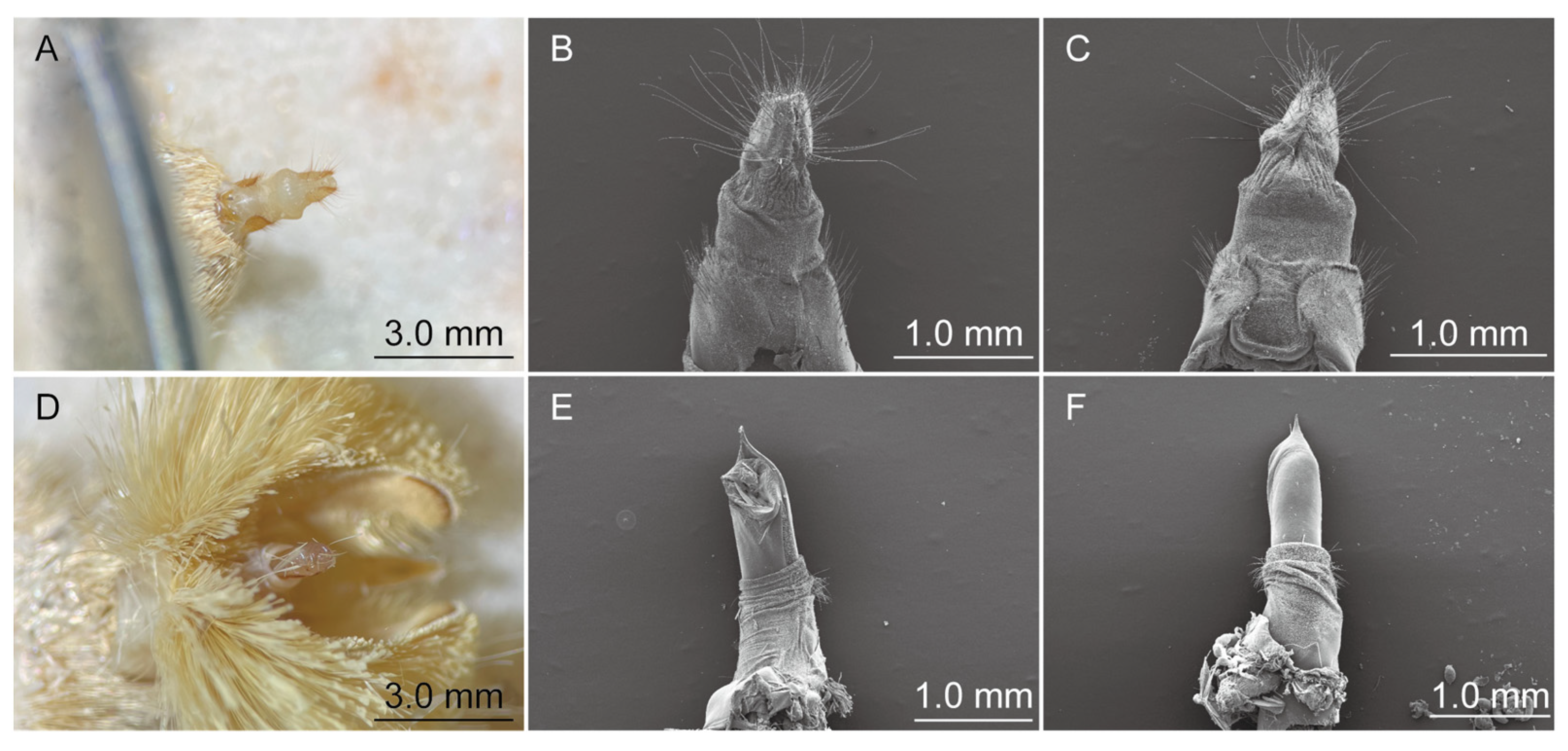
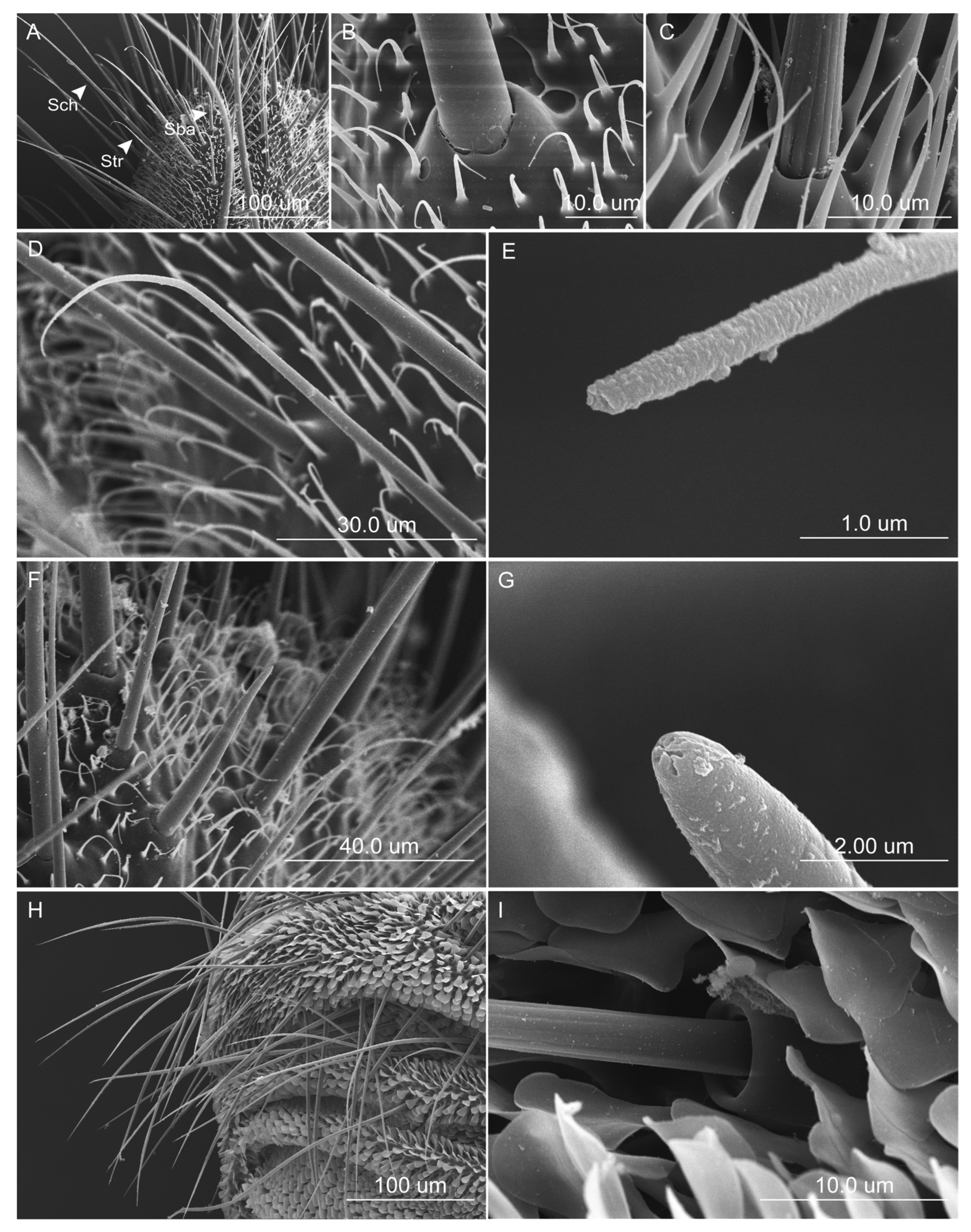
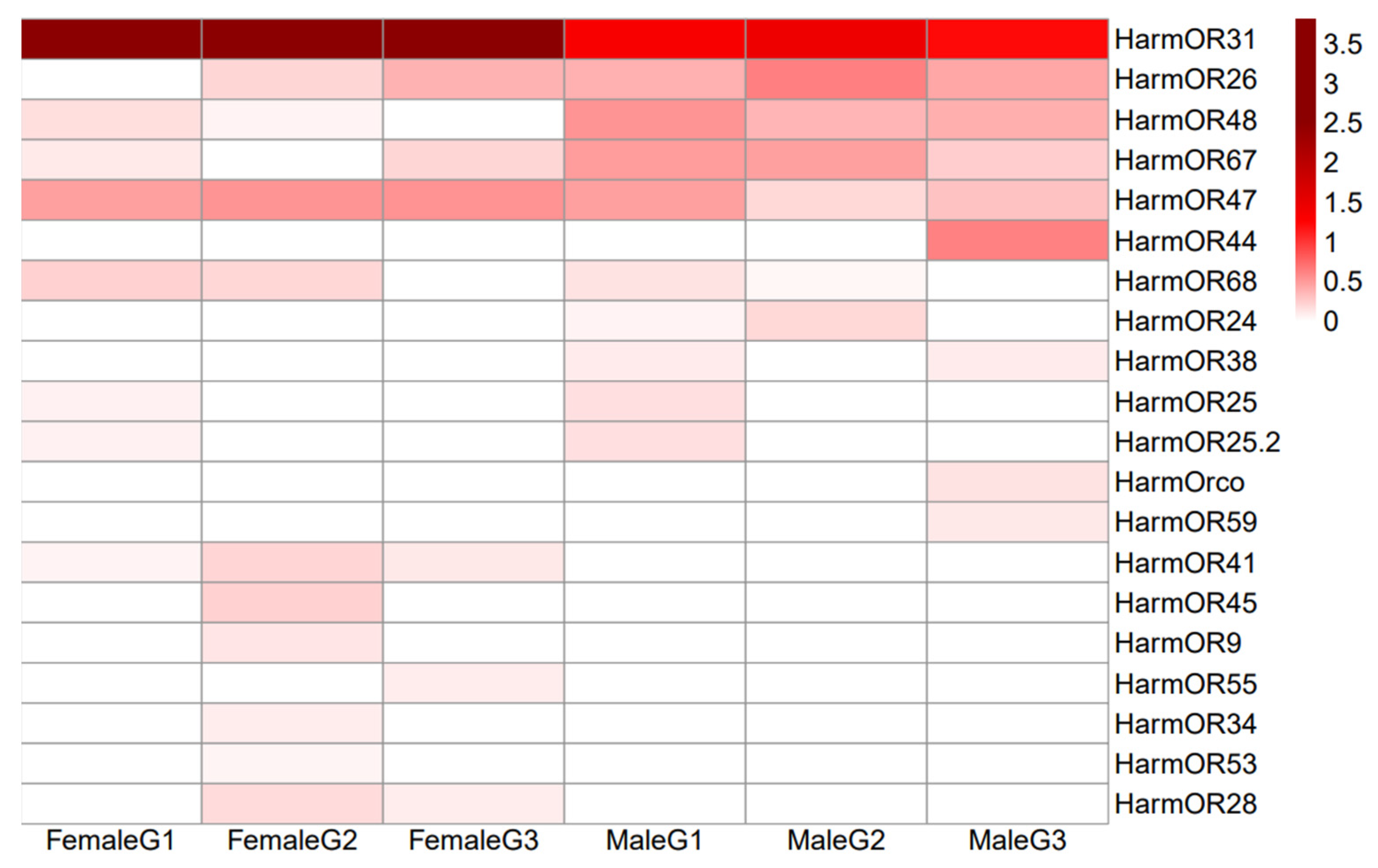

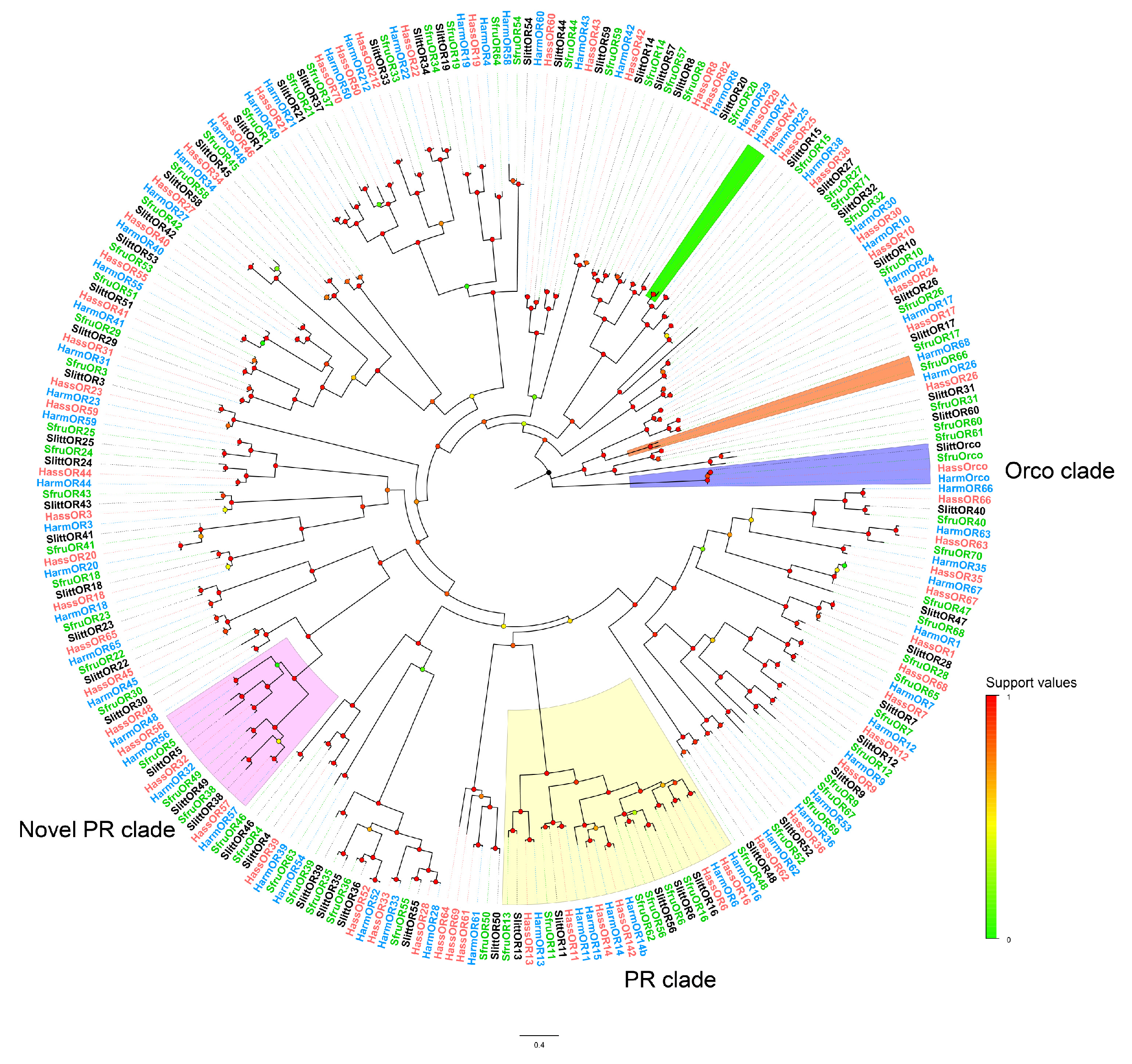

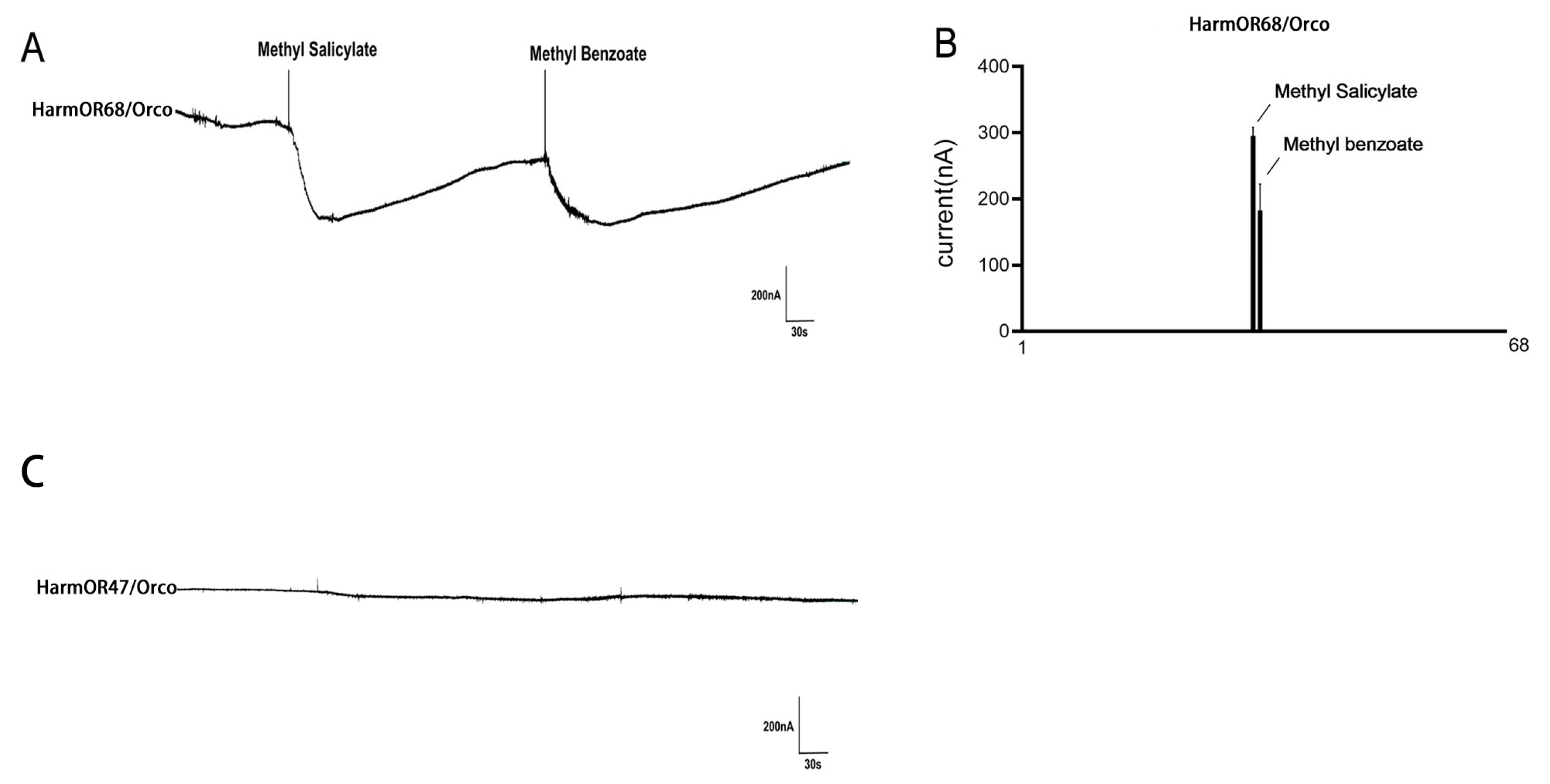
| Usage | Primer Name | Primer Sequences |
|---|---|---|
| Gene cloning | HarmOR68-F | ATGGCAGAAAACTTATCGTATTTCGGC |
| HarmOR68-R | TCAATTAGTGTTCTTCAGAAATG | |
| HarmOR47-F | ATGCCGTCCGATCAATCTAAAATGTTTG | |
| HarmOR47-R | CTATGTTTCTTGAGCATTTCTAATAAGTGTGAGAAAGA | |
| Vector construction | HarmOR68E-F | TCAGGGCCCgccaccATGGCAGAAAACTTATCGTATTTCGGC (Apa I) |
| HarmOR68E-R | TCAGCGGCCGCTCAATTAGTGTTCTTCAGAAATG (Not I) | |
| HarmOR47E-F | TCAGGGCCCgccaccATGCCGTCCGATCAATCTAAAATGTTTG (Apa. I) | |
| HarmOR47E-R | TCAGCGGCCGCCTATGTTTCTTGAGCATTTCTAATAAGTGTGAGAAAGA (Not. I) | |
| qPCR | HarmOR68-F | AATCCTGCTGCGAGTATTTAACACC |
| HarmOR68-R | AAGGTAGCCATATTGCGAACTCAAC | |
| HarmOR47-F | AAAATTATCAGCCGAAGAG | |
| HarmOR47-R | CTGGCATCAGCAAACTACAC |
| No. | Odorant | CAS Number | No. | Odorant | CAS Number |
|---|---|---|---|---|---|
| 1 | 2,6-di-tert-butylphenol | 128-39-2 | 35 | Heptanal | 111-71-7 |
| 2 | Acetophenone | 98-86-2 | 36 | Phenylacetaldehyde | 122-78-1 |
| 3 | Eugenol | 97-53-0 | 37 | 4′-ethylacetophenone | 937-30-4 |
| 4 | 2-phenylethanol | 60-12-8 | 38 | Jasmone | 488-10-8 |
| 5 | trans-3-hexen-1ol | 928-97-2 | 39 | (±)-camphor | 76-22-2 |
| 6 | 3,7-dimethyl-3-octanol | 78-69-3 | 40 | 2-pentadecanone | 2345-28-0 |
| 7 | (1r)-(-)-myrtenol | 19894-97-4 | 41 | (-)-piperitone | 4573-50-6 |
| 8 | (-)-trans-pinocarveol | 547-61-5 | 42 | Myrcene | 123-35-3 |
| 9 | (-)-linalool | 126-91-0 | 43 | (-)-trans-caryophyllene oxide | 1139-30-6 |
| 10 | Linalool | 78-70-6 | 44 | Farnesene, mixture of isom | 502-61-4 |
| 11 | (+)-cedrol | 77-53-2 | 45 | Ocimene | 13877-91-3 |
| 12 | cis-3-hexen-1-ol | 928-96-1 | 46 | (R)-(+)-limonene | 5989-27-5 |
| 13 | 4-methoxybenzyl alcohol | 105-13-5 | 47 | A-pinene | 80-56-8 |
| 14 | 1-octanol | 111-87-5 | 48 | (-)-β-pinene | 18172-67-3 |
| 15 | Benzyl alcohol | 100-51-6 | 49 | Camphene | 79-92-5 |
| 16 | 4-hydroxy-4-methyl-2pentanone | 123-42-2 | 50 | A-Humulene | 6753-98-6 |
| 17 | 1-octen-3-ol | 3391-86-4 | 51 | (S)-(-)-limonene | 5989-54-8 |
| 18 | Eucalyptol | 470-82-6 | 52 | A-terpinene | 99-86-5 |
| 19 | Β-citronellol | 106-22-9 | 53 | (-)-trans-caryophyllene | 87-44-5 |
| 20 | Geraniol | 106-24-1 | 54 | Methyl benzoate | 93-58-3 |
| 21 | cis-2-hexen-1-ol | 928-94-9 | 55 | Decalactone | 705-86-2 |
| 22 | 1-heptanol | 111-70-6 | 56 | Geranyl acetate | 105-87-3 |
| 23 | 1s-(-)-verbenone | 1196-01-6 | 57 | (Z)-3-hexenyl acetate | 3681-71-8 |
| 24 | 1-hexanol | 111-27-3 | 58 | Methyl 2-methoxy benzoate | 606-45-1 |
| 25 | (S)-cis-verbenol | 18881-04-4 | 59 | Butyl salicylate | 2052-14-4 |
| 26 | trans-2-hexen-1-al | 6728-26-3 | 60 | Methyl phenylacetate | 101-41-7 |
| 27 | Salicylaldehyde | 90-02-8 | 61 | trans-2-hexenyl acetate | 2497-18-9 |
| 28 | (±)-Citronellal | 106-23-0 | 62 | Benzyl acetate | 140-11-4 |
| 29 | Cinnamaldehyde | 104-55-2 | 63 | Methyl salicylate | 119-36-8 |
| 30 | 4-ethylbenzaldehyde | 4748-78-1 | 64 | 2-hexanol | 626-93-7 |
| 31 | 3-vinylbenzaldehyde | 19955-99-8 | 65 | 3-hexanol | 623-37-0 |
| 32 | Nonanal | 124-19-6 | 66 | trans-2-hexen-1-ol | 928-95-0 |
| 33 | (1r)-(-)-myrtenal | 18486-69-6 | 67 | Octanal | 124-13-0 |
| 34 | Benzaldehyde | 100-52-7 |
Disclaimer/Publisher’s Note: The statements, opinions and data contained in all publications are solely those of the individual author(s) and contributor(s) and not of MDPI and/or the editor(s). MDPI and/or the editor(s) disclaim responsibility for any injury to people or property resulting from any ideas, methods, instructions or products referred to in the content. |
© 2024 by the authors. Licensee MDPI, Basel, Switzerland. This article is an open access article distributed under the terms and conditions of the Creative Commons Attribution (CC BY) license (https://creativecommons.org/licenses/by/4.0/).
Share and Cite
Liu, W.; Sun, D.; Wang, X.; Wang, Z.; Liu, Y. Identification and Functional Characterization of an Odorant Receptor Expressed in the Genitalia of Helicoverpa armigera. Agriculture 2024, 14, 1030. https://doi.org/10.3390/agriculture14071030
Liu W, Sun D, Wang X, Wang Z, Liu Y. Identification and Functional Characterization of an Odorant Receptor Expressed in the Genitalia of Helicoverpa armigera. Agriculture. 2024; 14(7):1030. https://doi.org/10.3390/agriculture14071030
Chicago/Turabian StyleLiu, Weihao, Dongdong Sun, Xiaoqing Wang, Zhiqiang Wang, and Yang Liu. 2024. "Identification and Functional Characterization of an Odorant Receptor Expressed in the Genitalia of Helicoverpa armigera" Agriculture 14, no. 7: 1030. https://doi.org/10.3390/agriculture14071030
APA StyleLiu, W., Sun, D., Wang, X., Wang, Z., & Liu, Y. (2024). Identification and Functional Characterization of an Odorant Receptor Expressed in the Genitalia of Helicoverpa armigera. Agriculture, 14(7), 1030. https://doi.org/10.3390/agriculture14071030






